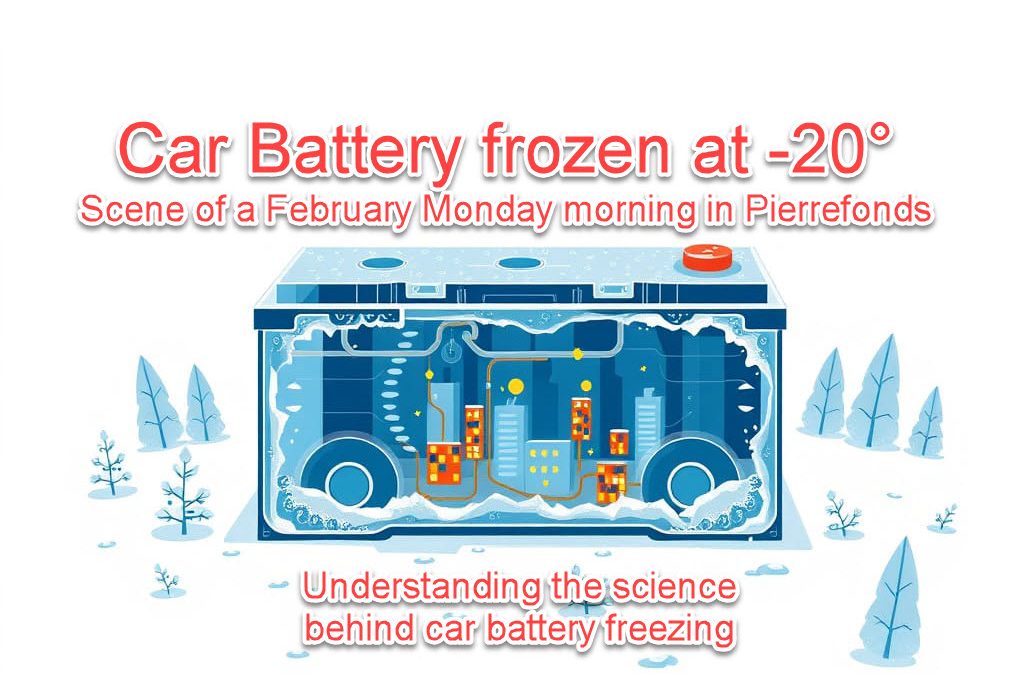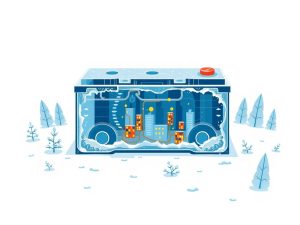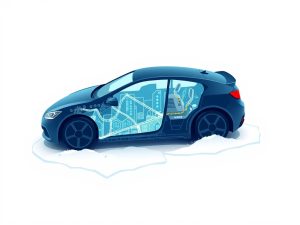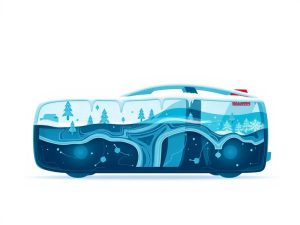
Car Battery in Distress – Imagine the scene: it’s a freezing morning in Montreal, the thermometer shows a merciless -20°C. You wake up, still groggy, and head to the kitchen. The comforting aroma of freshly brewed coffee fills the air, promising a warm start to the day despite the biting cold outside. You savor your first sip, letting the warmth of the beverage warm you from the inside, while preparing breakfast for your still sleepy children.
Minutes tick by, punctuated by the sound of spoons against cereal bowls and morning conversations. Gradually, the house comes to life. Backpacks are checked, coats are put on, and scarves are wrapped around necks. Everyone is ready to face this winter day.
You slip into your coat, grab your keys, and step out into the frigid air. Your breath forms small clouds in front of your face as you head towards your car, parked in the driveway. With a habitual gesture, you press the remote to start the engine, already anticipating the welcome warmth that will greet you in the cabin in a few minutes.
But nothing happens.
The engine remains desperately silent.
You try again, once, twice, three times. Still nothing. The icy silence of winter is broken only by the sound of your steps on the crunching snow as you approach the vehicle, worry beginning to set in. What happened?
The Brutal Awakening of a Winter Morning
This scenario, though frustrating, is unfortunately common during cold Montreal mornings. It represents the nightmare of many drivers who, like you, suddenly find themselves stuck, their morning routine brutally interrupted by a vehicle that stubbornly refuses to come to life.
The cause of this inconvenience often lies in an essential but often neglected component of your vehicle: the battery. Tonight, while you slept peacefully, your car battery waged a silent battle against the merciless cold, a battle it finally lost at the first light of dawn.
To understand what really happened, we need to dive into the depths of your car battery and observe the drama that unfolded during this icy night.
Understanding the Science Behind a Frozen Car Battery
Imagine your battery as a small industrial city, buzzing with activity. In this city, the inhabitants are ions, tiny charged particles that constantly move from one end of the city to the other, carrying the electricity needed to power your car.
The streets of this city are made of a liquid called electrolyte, which allows ions to move freely. The city’s factories are the battery’s lead plates, where chemical reactions that generate electricity occur.
On a normal day, the city functions perfectly. Ions move quickly through the streets, factories run at full capacity, and there’s enough energy to power all your car’s systems, including the powerful starter motor.
But when extreme cold sets in, like during this night at -20°C, the city begins to slow down. Here’s what happens:
The Slowdown of Battery City

1. The streets freeze: The electrolyte, normally fluid, becomes thick and viscous due to the cold. It’s as if the streets of our city were suddenly covered with black ice. The ions, our little workers, have much more difficulty moving.
2. Factories slow down: With the cold, chemical reactions in the lead plates become slower. It’s as if the machines in our factories were starting to freeze, producing less energy.
3. Demand increases: Paradoxically, the cold also makes engine oil thicker, which means the engine needs more energy to start. It’s as if, in addition to the frost, the city suddenly had to face an increased demand for electricity.
4. Reserves are depleted: Throughout the night, the battery continues to provide a little energy to maintain essential car systems (like the alarm or on-board computer). With the cold slowing down production, it’s as if the city was drawing on its reserves without being able to replenish them.
The Dawn of Despair
As dawn breaks over our battery city, the situation is critical. The streets are almost impassable, factories are running at a slow pace, and energy reserves are at their lowest.
When you press the remote start button, it’s as if you’re suddenly asking this sleeping and frozen city to wake up at once and provide a massive amount of energy. But the city is too numb, too slowed down by the cold to respond to this sudden demand.
The result? Your battery, normally capable of delivering up to 600 amperes to start the engine, now struggles to produce half of that. It’s insufficient to overcome the resistance of the thickened oil and turn the engine over.
This is how you find yourself, that morning, in front of a silent and immobile car, victim of the battle lost by your battery against the merciless cold of the Montreal winter.
The Crucial Importance of Battery Maintenance
This type of incident, as frustrating as it is, underlines the vital importance of good car battery maintenance, particularly in preparation for winter. A well-maintained battery will be better equipped to withstand the assaults of cold and will save you from these morning inconveniences that can disrupt your entire day.
Preparing Your Battery for Winter
Preparing your battery for winter is a bit like preparing our imaginary city to face a long period of frost. Here are some essential tips:
1. Regular charge state check:
Have your battery’s charge state checked regularly, especially before winter arrives. It’s like doing an audit of our city’s energy reserves. A weak battery even before the cold arrives will have much more difficulty surviving icy nights. A professional can measure your battery’s voltage and its ability to hold a charge, giving you a precise idea of its health status.
2. Cleaning the terminals:
The battery terminals are like the entry and exit gates of our city. If they are covered with corrosion, it’s as if these gates were blocked by rust, preventing energy from flowing freely. Clean the terminals regularly with a wire brush and a baking soda solution to ensure optimal connection.
3. Thermal insulation:
If possible, park your car in a heated garage. It’s as if you were offering your battery-city a shield against the outside cold. If this isn’t possible, consider using a battery heating blanket. These devices act like a cozy coat for your battery, helping it maintain a more clement temperature even in extreme cold.
4. Limiting accessories at startup:
When you start your car in cold weather, turn off all non-essential accessories (radio, lights, air conditioning). It’s as if you were asking your city to concentrate all its energy on its most important task: starting the engine. Once the engine is running, you can gradually turn these systems back on.
5. Regular driving:
In winter, try to drive your car regularly, even for short trips. It’s like keeping your city in constant activity, preventing it from becoming completely numb. Driving allows the alternator to recharge the battery, thus compensating for the energy loss due to cold.
6. Alternator test:
The alternator is like the main power plant of our city. It recharges the battery while the engine is running. A faulty alternator can let your battery discharge gradually, making it more vulnerable to cold. Have your alternator checked at the same time as your battery to ensure it’s working properly.
Warning Signs of a Car Battery in Trouble
Like any well-managed city, your battery will send you alarm signals before completely collapsing. Here are some signs to watch out for:
1. Slow start:
If your engine seems “lazy” at startup, taking longer than usual to come to life, it’s as if your battery-city was struggling to gather enough energy for the big “startup party”. This is often the first sign of a weakening battery.
2. Dim lights:
If your headlights seem less bright, especially at idle, it’s as if the street lamps in your city were operating at half power due to lack of energy. This may indicate that your battery is struggling to maintain sufficient charge.
3. Capricious electrical accessories:
If your power windows go up and down more slowly than usual, or if your audio system seems to lack punch, it’s as if the different neighborhoods of your city suddenly lacked energy for their usual activities.
4. Sulfur odor:
For older car batteries, a rotten egg smell coming from under the hood may indicate a battery leak. It’s as if the “sewers” of your city were overflowing, spreading harmful chemicals. In this case, immediate inspection is necessary.
5. Battery warning light on:
If the battery light on your dashboard comes on, it’s the equivalent of your city’s alarm siren going off. Don’t ignore it!
Certainly, I’ll continue the translation:
Beyond the Car Battery: The Importance of a Comprehensive Inspection
Although the battery is often the weak link in winter, it’s only part of the complex puzzle that is your vehicle. That’s why a comprehensive inspection of your car is crucial to face winter with peace of mind.
Imagine your car as a large metropolis, of which the battery is just one neighborhood among others. Each system in your vehicle is like a different district, each with its vital role to play in keeping the city functioning properly.
That’s why every winter, our team of technicians offers a complete inspection of your vehicle, starting with the battery, but including the whole range at an unbeatable price. Here’s why each of these inspection points is crucial for your safety and the proper functioning of your vehicle in winter:
1. Battery condition:
Battery tests and inspections are essential to avoid unexpected breakdowns. As we’ve seen, cold can significantly affect your battery’s performance. A weak battery can leave you stranded at the most inopportune moment. Our technicians will check not only the battery charge but also the condition of the terminals and cables to ensure that energy flows freely in your “automobile city”.
2. Tire condition and pressure:
Ensuring optimal traction and inflation is paramount in winter. Underinflated or worn tires can seriously compromise your safety on slippery roads. Moreover, tire pressure naturally decreases with cold, which affects vehicle handling and increases fuel consumption. Our inspection will check the condition of your tires and adjust their pressure for optimal performance.
3. Fluid levels and antifreeze:
Checking the coolant and other essential fluids is crucial to avoid freezing or overheating. An inadequate antifreeze mixture can cause the coolant to freeze, causing catastrophic engine damage. Similarly, insufficient levels of other fluids can affect your vehicle’s performance and safety. Our technicians will ensure that all fluids are at the right level and have the right composition to withstand the cold.
4. Oil and filter:
Checking oil viscosity and recommending changes if necessary are essential in winter. Oil tends to thicken in cold weather, which can make starting more difficult and increase engine wear. Winter-appropriate oil and a clean filter will allow your engine to function efficiently even in extreme cold.
5. Windshield wipers and washer fluid:
Ensuring clear visibility is crucial for your safety in winter. Worn wipers or inadequate washer fluid can seriously compromise your visibility in snowy or icy conditions. We will check the condition of your wipers and fill your reservoir with cold-resistant high-performance washer fluid to guarantee clear vision in all circumstances.
6. Brakes, belts, and hoses:
Inspection to detect any signs of wear or damage that could worsen in cold weather is vital. Winter salt and moisture can accelerate corrosion and wear of these essential components. Brakes in poor condition can be catastrophic on slippery roads, while worn belts or hoses can suddenly fail, leaving you stranded in the cold. Our thorough inspection of these elements ensures that your vehicle is ready to face the rigors of winter safely.
As you can understand, a complete inspection of your vehicle before winter is not a luxury, it’s a necessity. Each component of your car plays a crucial role in your safety and comfort during the cold months. A failing battery, unsuitable tires, or worn brakes can turn a simple journey into a stressful, even dangerous experience.
That’s why we are proud to present our special offer for a complete winter inspection. What’s included?:
1. Battery condition: Thorough diagnosis and performance tests to prevent unexpected breakdowns, ensuring reliable starting even in extreme cold.
2. Tire condition and pressure: Careful assessment of wear, precise pressure adjustment, and balance check for optimal traction and handling on winter roads.
3. Fluid levels and antifreeze: Rigorous inspection of coolant and other essential fluids, with adjustment of concentrations for maximum protection against freezing and overheating.
4. Oil and filter: Analysis of oil viscosity adapted to winter temperatures, examination of filter condition, and personalized recommendations for necessary changes.
5. Windshield wipers and washer fluid: Check of wiper efficiency, replacement if necessary, and filling with high-performance washer fluid resistant to extreme temperatures for optimal visibility.
6. Brakes, belts, and hoses: Detailed examination of braking system components, drive belts, and hoses to detect any signs of wear or damage likely to worsen in harsh winter conditions.
 Get it all for only $32.49, a 50% discount off the regular price of $64.99!
Get it all for only $32.49, a 50% discount off the regular price of $64.99!
But hurry, this offer ends February 28th!
This exceptional offer allows you to benefit from a complete inspection at an unbeatable price. Our experienced technicians will thoroughly examine every crucial aspect of your vehicle, from the battery to the brakes, including tires and fluids. It’s the ideal opportunity to prepare your car to face the rigors of Montreal winter with peace of mind.
Don’t wait until it’s too late. Trust a CAA recommended garage and use car maintenance specialists. To book your vehicle check with the experts at [Autotech Performance in Pierrefonds, schedule your appointment online here. Take advantage of this limited offer to ensure that your “automobile city” is ready to face the challenges of winter.




